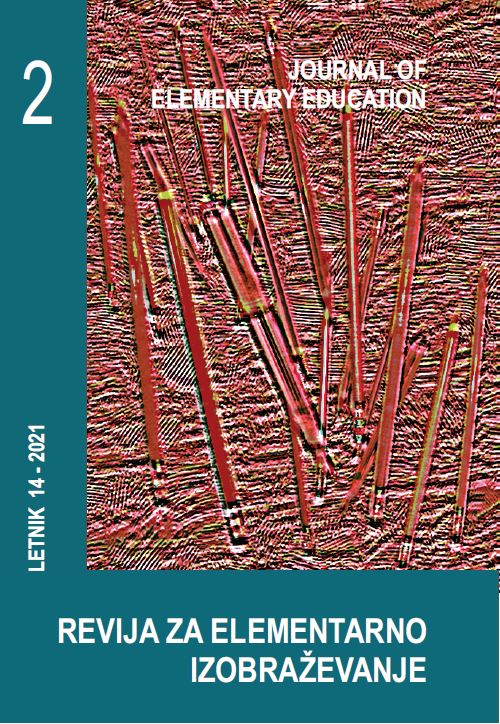Analogical Reasoning in Geometry Proofs
DOI:
https://doi.org/10.18690/rei.14.2.149-170.2021Keywords:
analogical reasoning, cognition, geometry proofs, proving theoremAbstract
This study aimed at investigating six high school students’ use of analogies while working through geometry proofs in group settings. Along with the analogies used by students and analysis of how they were used, as well as discourse analysis, we investigate students’ meta-proof comments to glean some interpretation of students’ beliefs about proofs. Overall, this study found that students had different beliefs about the nature and process of proofs and used and understood analogical reasoning in idiosyncratic ways. However, it was also found that students’ greater use of analogies did not automatically lead to more success with proofs.
Downloads
References
Anderson, K., Casey, B., Thompson, W., Burrage, M., Pezaris, E., Kosslyn, S. (2008). Performance on middle school geometry problems with geometry clues matched to three different cognitive styles. Mind, Brain, and Education, 2(4), 188–197.
Bell, C. (2011). Proofs without words: A visual application of reasoning and proof. Mathematics Teacher, 104(9), 690–695.
Bem, D. (2011). Feeling the future: Experimental evidence for anomalous retroactive influences on cognition and affect. Journal of Personality and Social Psychology, 100, pp. 407–425
Boesen, J., Lithner, J, & Palm, T. (2010). The relation between types of assessment tasks and the mathematical reasoning students use. Educational Studies in Mathematics, 75, pp. 89–105.
Bogdan, K. & Biklen, H. (2003). Qualitative Research for Education: An introduction to theories and methods (4th ed.). Boston: Allyn and Bacon.
Creswell, J. (2003). Research Design: Qualitative, quantitative and mixed methods approaches (2nd ed.). London: Sage Publications.
Frans, C. & Kosolosky, T. (2014). Mathematical proofs in practice: Revisiting the reliability of published mathematical proofs. Theoria: An International Journal for Theory, History and Foundations of Science, 29(3), pp. 345–360.
Flick, U. (2009). An Introduction to Qualitative Research (4th Ed.). Thousand Oaks, CA: Sage.
Gathercole, S. and Pickering, S. (2000). Assessment of working memory in six- and seven-year-old children. Journal of Educational Psychology, 92(2), pp. 377–390.
Goldin, A. (2000). A scientific perspective on structure: task-based interviews in mathematics education research. In A. Kelly and R. Lesh (Eds.), Handbook of Research Design in Mathematics and Science Education (pp. 517–546). Mahwah, NJ: Lawrence Erlbaum Associates.
Grcar, F. (2013). Errors and corrections in mathematics literature. Notices of the American Mathematical Society, 60, pp. 418–425.
Haavold, E. (2011). What characterises high achieving students’ mathematical reasoning? In Sriraman, B. and Lee, K. H. (Eds.), The Elements of Creativity and Giftedness in Mathematics (Vol. 1) (pp. 193–215). Sense Publishers.
Hanna, U. & de Villiers, J. (2008). ICMI Study 19: Proof and proving in mathematics education. ZDM Mathematics Education, 40(2), pp. 329–336.
Lamport, L. (2012). How to write a 21st century proof. Journal of Fixed Point Theory and Applications, 11, 43–63.
Jonsson, B., Norqvist, M., Liljekvist, Y., & Lithner, T. (2014). Learning mathematics through algorithmic and creative reasoning. Journal of Mathematical Behaviour, 36, pp. 20–32.
Lin, H. Jr. & Lin, H. (2011). Cognitive load for configuration comprehension in computer-supported geometry problem solving: An eye movement perspective. International Journal of Science and Mathematics Education, 12(3), pp. 605–627.
Magda, L. (2015). Analogical reasoning in geometry education. Acta Didactica Napocensia, 8(1), pp. 57–65.
Miles, M. B. & Huberman, M (1994). Qualitative Data Analysis: an expanded sourcebook. Thousand Oaks, CA: Sage.
Park, K., Moreno, G., Seufert, H., & Brunken, W. (2010). Does cognitive load moderate the seductive details effect? A multimedia study. Computers in Human Behavior, 27(1), pp. 5–10.
Patkin, K. (2011). High school students’ perceptions of geometrical proofs proving and refuting geometrical claims of the ‘for every …’ and ‘there exists’ type. International Journal of Mathematics Education in Science and Technology, 43(8), pp. 985–998.
Pfeiffer, K. (2010). The role of proof validation in students’ mathematical learning. MSOR Connections, 10(2), pp. 17–21.
Schwonke, C., Renkl, H., Salden, E. & Aleven, B. (2011). Effects of different ratios of worked solution steps and problem solving opportunities on cognitive load and learning outcomes. Computers in Human Behavior, 27(1), pp. 58–62.
Stavrou G. (2014). Common errors and misconceptions in mathematical proving by education undergraduates. Issues in the Undergraduate Mathematics Preparation of School Teachers. 1, pp. 1–8.
Strauss, A. & Corbin, J. (1990). Basics of Grounded Theory Methods. Beverly Hills, CA.: Sage.
Stylianides, D. & Andreas. G. (2009). Breaking the equation “empirical argument = proof.” Mathematics Teaching, 213, pp. 9–14.
Tall, D. (1998). The cognitive development of proof: Is mathematical proof for all or for some? Conference of the University of Chicago School Mathematics Project, August, 1998. Journal of Mathematical Behavior, 33, pp. 72–87
Tall, D. (2008). The transition to formal thinking in mathematics. Mathematics Education Research Journal. 20(2), pp. 5–24.
Van Bendegem, H. (2014). The impact of the philosophy of mathematical practice on the philosophy of mathematics. In: L. Soler, S. Zwart, M. Lynch and V. Israel-Jost (Eds.), Science after the Practice Turn in the Philosophy, History, and Social Studies of Science (pp. 215–226). London: Routledge.
van den Broek, G. S .E., Takashima, H., Segers, D., Fernández, H. & Verhoeven, D. (2013). Neural correlates of testing effects in vocabulary learning. Neuroimage, 78, pp. 94–102.
Varghese, T. (2009). Secondary-level student teachers’ conceptions of mathematical proof. Issues in the Undergraduate Mathematics Preparation of School Teachers, 1, pp. 1–14.
Wertsch, D. (1990). The voice of rationality in a sociocultural approach to mind. In Moll, L. C. (Ed.), Vygotsky and Education: Instructional implications and applications of sociohistorical psychology, (pp. 175–205). New York, NY: Cambridge University Press.
Wertsch, F., Hagstrom, H., & Kikas, G. (1995). Voices of thinking and speaking. In Martin, L., Nelson, K., and Tobach, E., (Eds.) Sociocultural Psychology: Theory and practice of doing and knowing, (pp. 276–292). New York, NY: Cambridge University Press.
Wiklund-Hörnqvist, D., Jonsson, H., & Nyberg. H. (2014). Strengthening concept learning by repeated testing. Scandinavian Journal of Psychology, 55(1), pp. 10–16
Downloads
Published
Issue
Section
License
Copyright (c) 2021 Anass Bayaga, Michael J. Bosse, John Sevier

This work is licensed under a Creative Commons Attribution 4.0 International License.
